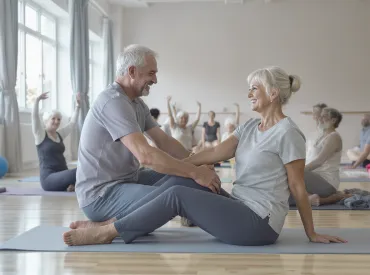
Can You Dissolve Bone Spurs Naturally? An Evidence-Based Guide
Learn the truth about 'dissolving' bone spurs. Explore evidence-based natural remedies and lifestyle changes to manage pain and inflammation effectively.

Learn the truth about 'dissolving' bone spurs. Explore evidence-based natural remedies and lifestyle changes to manage pain and inflammation effectively.

Experiencing shoulder pain while pregnant? Learn the difference between common aches and serious warning signs like ectopic pregnancy or preeclampsia. Find safe relief.

Explore the causes, symptoms, and comprehensive treatment options for disc desiccation. Learn about rehydration, surgery, and how lifestyle affects your spine.

Is your shoulder pain a mild strain or a serious tear? Learn the key differences in symptoms, causes, and treatment options for rotator cuff injuries.

A comprehensive guide to understanding finger cramps, from common causes like overuse and dehydration to underlying conditions. Learn immediate relief and prevention.

A comprehensive guide to understanding stiff fingers, from common causes like arthritis to systemic health links. Learn about treatments, exercises, and when to see a doctor.

Experiencing sharp back pain when you cough? Learn the common causes, from muscle strain to herniated discs, and discover effective treatments and prevention tips.

Learn everything about a hyperextended elbow, from symptoms and first aid to long-term consequences and prevention. A complete guide for patients and athletes.

Understand levoscoliosis, a left-curving spine. Learn about its symptoms, causes, why it's a 'red flag,' and effective non-surgical and surgical treatments.

Suffering from a sharp side pain? Learn everything about a torn oblique, from symptoms and diagnosis to recovery timelines, effective treatments, and prevention.

Hearing a crack or pop in your chest when you stretch is common. We explore the science behind it, from harmless gas bubbles to signs you should see a doctor.

Tired of hip pain from sitting? Discover common causes like bursitis, tight hip flexors, and sciatica. Find expert-backed tips for relief and prevention.
Our bodies are remarkable machines, capable of everything from lifting heavy objects to performing delicate, precise movements. The foundation of this incredible ability is the musculoskeletal system—an intricate network of bones, joints, and muscles that provides structure, support, and mobility. Understanding this system is the first step toward maintaining a lifetime of strength, flexibility, and activity.
The musculoskeletal system, also known as the locomotor system, is a complex partnership between your skeleton and muscles, connected by a network of tendons, ligaments, and cartilage. Together, they allow you to interact with the world around you.
Your skeleton is the body's internal framework. Far from being static, bones are living, active tissues that perform several critical functions.
Bones have a unique composition that makes them both strong and relatively lightweight. They are built on a flexible framework of a protein called collagen, which is hardened by a mineral complex of calcium phosphate. This combination gives bone its resilience and rigidity.
Bones are comprised of two main types of tissue:
!Illustration of the Musculoskeletal System:watermark(/images/watermark_5000_10percent.png,0,0,0):watermark(/images/logo_url.png,-10,-10,0):format(jpeg)/images/overview_image/127/aEnD13jzVZg0xpjmoMibQA_skeletal-system_en.jpg "The human musculoskeletal system. Source: Kenhub")
The 206 bones in the adult skeleton are classified by their shape:
Bone health is a dynamic process. Throughout life, old bone is broken down by cells called osteoclasts, while new bone is formed by osteoblasts. This "remodeling" ensures your skeleton remains strong and can repair itself from minor damage. Peak bone mass is typically achieved in early adulthood, after which the balance of remodeling gradually shifts.
With over 600 in the body, muscles are the engines that power movement. They contract and relax to pull on bones, allowing us to walk, talk, chew, and perform every other physical action.
Skeletal muscles work in pairs to create coordinated motion. A flexor muscle contracts to bend a limb at a joint, while its partner, the extensor, relaxes. To straighten the limb, the extensor contracts, and the flexor relaxes. A classic example is the bicep (flexor) and tricep (extensor) in the upper arm.
Joints are the crucial points where two or more bones meet. They are essential for flexibility and movement.
A healthy musculoskeletal system doesn't happen by accident. It requires a lifelong commitment to good nutrition, regular exercise, and proactive care, with special considerations at different stages of life.
Exercise places mechanical stress on your bones and muscles, signaling them to become stronger.
Childhood and adolescence are critical periods for building peak bone mass. However, young athletes are also susceptible to specific injuries. Overuse can cause stress on growth plates, and it's essential to prevent injuries through proper preparation. Programs like FIFA 11+ for soccer and the Thrower's 10 for overhead sports can strengthen key muscle groups and reduce injury risk.
Reference: Cedars-Sinai highlights the importance of injury-prevention programs and proper nutrition for young athletes. Source
Many women are unprepared for what orthopedic surgeon Dr. Vonda Wright calls the "musculoskeletal syndrome of menopause." The decline in estrogen during this transition has a profound effect:
Reference: Excerpt from Dr. Vonda Wright's book UNBREAKABLE. Source: Oprah Daily
As we age, wear and tear can lead to conditions like osteoarthritis, where the cartilage in joints breaks down. However, age-related decline is not inevitable.
Reference: AARP provides practical advice for joint care after 50. Source
Despite our best efforts, the musculoskeletal system can be affected by various injuries and diseases.
Diagram showing types of joints
Your musculoskeletal system can also offer clues about your overall health and possesses a remarkable capacity for healing.
Sometimes, musculoskeletal pain is not a primary problem but a symptom of an underlying systemic illness. For example:
Recognizing these connections is crucial for accurate diagnosis and treatment.
You should consult a doctor if you experience persistent pain, swelling, stiffness, or a decreased range of motion in any part of your musculoskeletal system. Healthcare professionals like physiotherapists, rheumatologists, and orthopedic surgeons specialize in diagnosing and treating these issues.